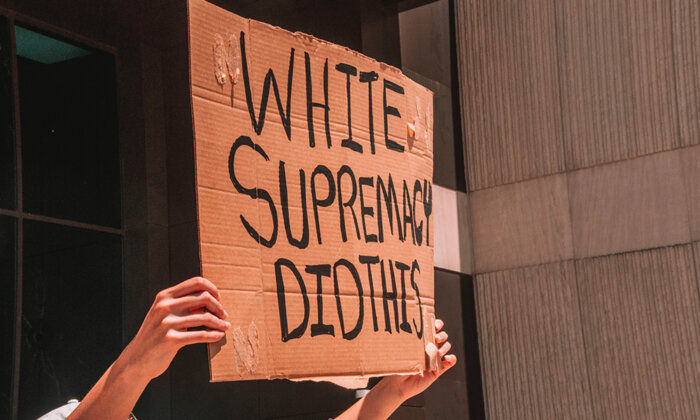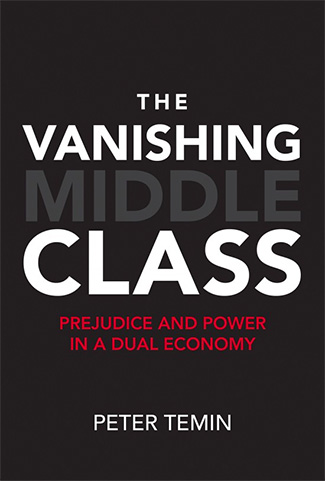The Oppressive, Enduring Legacy of 'Racecraft'

In America, racism has become racecraft, analogous to witchcraft. We no longer believe that witches ride on brooms, but we continue to believe that races have powers that we should fear. Attitudes toward race in the United States have become divorced from scientific and historic evidence that races do not exist. Even though people from different areas may look different from one another and have other different characteristics, there is too much diversity within groups and too much similarity between groups to provide the basis for any biological definition of race. “Racecraft is a ready-made propaganda weapon for use against the aspirations of the great majority of working Americans,” write the scholars (and sisters) Karen and Barbara Fields. “Sooner or later, tacitly or openly, any move to tackle inequality brings racecraft into play.”
Witchcraft made its last appearance in the future United States in the Salem witch trials of 1692. Accusations against the presumed witches were made in the context of Puritan religion, but there was a curious geography to the process. The individuals accused of witchcraft came from the eastern part of Salem, near the Atlantic coast that offered mercantile possibilities; the accusers came from the western part of Salem where fertile land encouraged traditional farming. Perhaps the furor over witchcraft and the dark arts even then was only the means to express the social conflict between the lure of commercial activity and the resistance to change among back-country farmers.

We no longer use the criminalization of witchcraft to express the differences in the community, but racecraft has endured. The reasons for this persistence are connected with American history, starting at the same time as the Salem witch trials. When Southern farmers first began to expand farming in the 17th century, they employed white and black workers equally, subject to restrictions held over from medieval practices. The farmers’ problem was not Africans, it was lack of labor to work their abundant land. They encouraged European immigration by loaning immigrants the money to get to America with their farm labor obligations as security. That is, the European workers would be indentured servants, who would regain their freedom of action when they had paid back their loan and their indentures were over. The farmers could not apply this approach to Africans because Africans did not come to America voluntarily. Most English and Dutch migrants came because they wanted to come, while Africans were captured and brought to America against their will. As the historians Oscar and Mary Handlin stated in a classic article, “To raise the status of Europeans by shortening their terms would ultimately increase the available hands by inducing their compatriots to emigrate; to reduce the Negro’s term would produce an immediate loss and no ultimate gain.”
Attitudes toward race in the United States have become divorced from scientific and historic evidence that races do not exist.
The expansion of the African slave trade at the end of the 17th century provided Southern planters with abundant labor in a framework that had developed to differentiate between whites and blacks. The difference that had opened up between Europeans and Africans led to plantation owners fearing “plots and conspiracies” against them, which led to further restrictions on enslaved people. The increasing need to get the consent of European workers during the 18th century contrasted sharply with decline in the independence of African slaves — who went from villeins to chattels. “When, therefore, Southerners in the 18th century came to think of the nature of the rights of man they found it inconceivable that Negroes should participate in those rights,” wrote Oscar and Mary Handlin in 1950. “It was more in accord with the whole social setting to argue that the slaves could not share those rights because they were not fully men, or at least different kinds of men. In fact, to the extent that Southerners … thought of liberty as whole, natural, and inalienable, they were forced to conclude that the slave was wholly unfree, wholly lacking in personality, wholly a chattel.”
The statement in the Declaration of Independence that “all men are created equal” meant that all white men were created equal. Black slaves were not included. And when slavery was abolished after the Civil War, the presumption that blacks were abominable and lacking in personality endured. Reconstruction faltered after the assassination of President Lincoln and ended finally in 1877. It was followed by Jim Crow laws and social controls that were created to reproduce something close to the antebellum relations between whites and blacks.
The continuation of discrimination against African Americans has been described as white rage by some historians. It seems hard to explain the long reach of old quarrels between the North and South without some such emotion. White rage is the other side of racecraft. This rage could be seen in the 2016 presidential campaign. The Democratic National Convention contained many kinds of people: white, black, and brown. And the National Review responded with a blast of white rage, identifying this diversity as anti-white, “a celebration of lawlessness and racial mythology that has led to violence.”
The federal government did little to disturb Southern discrimination in the first half of the 20th century since Southern Democrats had ample power to block any federal intervention. Southern congressmen represented only white Southerners as few blacks were able to vote. Jim Crow laws and violence kept black Southerners from exercising the rights given to them in the Fourteenth Amendment. Congressional representatives and senators were selected by the local elites since there was no opposition in the general election. And, once in Congress, they gained leadership positions and political power by the long tenure provided by this system.
Jim Crow laws and violence kept black Southerners from exercising the rights given to them in the Fourteenth Amendment. Congressional representatives and senators were selected by the local elites since there was no opposition in the general election.
Southern lawmakers exercised their power by leaving African Americans out of the federal programs of the New Deal. Instead of excluding them directly, they excluded occupations in which blacks were highly engaged, like farming and domestic service. They insisted that all federal social welfare programs be administered by state officials so that Southern officials were free to perpetuate Jim Crow standards. And they prevented Congress from including any antidiscrimination clauses into federal social welfare programs that distributed money to the South.
This system meant that poor Southerners, white and black, were left out of the relief offered to Northern workers during the Great Depression. Their living conditions were described vividly in “Let Us Now Praise Famous Men,” which united James Agee’s powerful prose with Walker Evans’s vivid photographs.
Social Security did not extend to blacks for the first quarter-century of its existence. The GI Bill provided educational benefits for veterans of the Second World War, but it did not guarantee admission to colleges. Few blacks were admitted to Northern colleges and universities due to bad Southern schooling. Blacks therefore applied to Southern black colleges — being excluded from Southern white colleges — which did not have capacity to take them. States refused to expand the facilities of black colleges, particularly dormitories, and much of the black demand for college education went nowhere. Black veterans also were not helped to get good jobs by the GI Bill. Local employment agencies funded by the bill directed them to traditional black jobs, ignoring learning that had occurred in the army, and often refused loans to black veterans because they lacked capital or credit ratings and lived in undesirable neighborhoods.
African Americans responded to the pressure on them in Southern states by moving north and west in the Great Migration. Black workers moved out of the oppressive South to better their lives and employment opportunities. But this move was not always successful, and blacks lost ground relative to whites after the Second World War. The national unemployment rate for blacks and whites was the same in 1930; the black rate was double that of whites in 1965. The unemployment rate for black teenage boys went from being slightly less than whites in 1948 to being almost twice as high in 1965. And the median income of black men declined to 53 percent of the income of white men in 1965.
The lower incomes and employment rate of blacks reduced their accumulation of wealth. Senator Elizabeth Warren recently gave an impassioned summary of black exclusions: “Entire legal structures were created to prevent African Americans from building economic security through home ownership,” she said. “Legally enforced segregation. Restrictive deeds. Redlining. Land contracts. Coming out of the Great Depression, America built a middle class, but systematic discrimination kept most African American families from being part of it.”
The national unemployment rate for blacks and whites was the same in 1930; the black rate was double that of whites in 1965.
The oppression of blacks, increasing rapidly after the war, began to meet opposition in the 1960s. The Civil Rights Movement that Johnson supported led to legislation that granted blacks legal rights to equal citizenship, but these laws were followed by the War on Drugs that generated a new system of mass incarceration that continued the Jim Crow tradition. By 2000, one out of three black men was spending time in jail. The rise of mass imprisonment put great pressure on many black families, and led to social as well as economic problems.
Nixon proclaimed the War on Drugs just as the Great Migration ended. Reagan and state governments expanded the war in the 1980s as the crack epidemic grew. Blacks were (and are) far more likely to be arrested for drug offenses than whites. At the same time, industry began to decline in the American Midwest, in what is now called the Rust Bowl, and the jobs that blacks came north to find began to disappear. They found conditions in the North better than in the South, but not as good as they had hoped.
The enduring reach of racecraft can be seen in the treatment of immigrants, even though biologists have not been able to provide a satisfactory definition of race that includes all members of a given race and excludes all others. In the 19th century, new immigrants typically were poor, and they were grouped with African Americans in the binary world of racecraft. Some immigrants fared so well in America that they graduated from being “black” to being “white.” Other immigrants did not fare so well, whether because of cultural attributes or the American context when they came. But the enduring influence of racecraft meant that the record of their American success was calibrated by racecraft.
A great many Irish came to America in the 19th century in response to the Irish famine at mid-century. They were grouped initially with blacks as despised manual workers. The new Irish immigrants joined with abolitionists to oppose slavery out of sympathy with their attempts to free Ireland from English rule. Only when many Irish Americans had abandoned this stance were they considered whites, who then joined other whites and adopted their racecraft.
Jews followed a similar immigrant path when they began to arrive at the end of the 19th century in response to pogroms in Eastern Europe. They were discriminated against, and restricted in where they could live, work, and sometimes simply stay during the first half of the 20th century — from the age of mass immigration from Eastern Europe to the end of the Second World War. There were a few rich Jews — the heirs of earlier court Jews — but they were the exception to the general rule. Most Jews were lumped in with blacks even though they were not black. After the tragic effects of the Second World War and in postwar prosperity, Jews began to be accepted everywhere; they had become white. But while they had made the transition, their movement did not affect the structure of race relations in America. Being white in America meant being superior to blacks, and many Jews adopted racecraft with their newly white status, according to anthropologist Karen Brodkin. Those who did shared its conventions of exclusion, while others remembered past discrimination and tried to help people who had not made it into the American mainstream.
As the dual economy developed in the late 20th century, large numbers of Latinos began immigrating to the United States in response to chaos in their homelands. There has been what might be called a second Great Migration of Latinos from Mexico and other Central American countries that followed the Great Migration of African Americans before 1970. The number of Latinos in the United States has grown from around 5 percent in 1970 to 17 percent today. The Latino population now exceeds the black population in the United States.
As with the Great Migration, Latinos moved north to escape repressive political regimes that denied them a path to economic advancement and security. American interventions in Central America to dislodge governments we did not approve of were followed by the North American Free Trade Agreement (NAFTA) in 1994. NAFTA exposed Mexico to the effects of globalization that had affected United States workers by then. But Mexican workers had an option that American workers lacked: they could move north to better their position.
This movement was international, not like the interstate movement of the Great Migration of African Americans. Just as the changing immigration laws of the 1920s led employers to look to the American South for workers, the end of internal U.S. migration led employers to look south of the American border for workers. The influx of Latinos, however, became entangled with the War on Drugs as Central America became a prime source for drugs. Attempts to stem the inflow of drugs led to stiffening of the Mexican border, leading in turn to an increasing number of unauthorized immigrants who have become a political football. The tension between American employers who want a new source of labor and American workers who are suffering already from the ills of globalization has kept the United States from updating its immigration policy for these new conditions.
Latinos now are overwhelmingly in the low-wage sector of the dual economy. They are concentrated in cities that lack resources for education; they are facing the same kind of social dysfunction of African American communities. There is the same perception in the white population that anyone in a Latino neighborhood is up to no good. Latinos are on the wrong side of racecraft.
“Whites who currently live in counties that had high concentrations of slaves in 1860 are on average more conservative and express colder feelings toward African Americans than whites who live elsewhere in the South.”
The effect of racecraft on redistributive politics has been described in many recent publications. A comparison of the United States with Europe concluded: “Racial discord plays a critical role in determining beliefs about the poor… Opponents of redistribution in the United States have regularly used race-based rhetoric to resist left-wing politics.”
A recent econometric analysis of American counties is worth quoting in detail: “Whites who currently live in counties that had high concentrations of slaves in 1860 are on average more conservative and express colder feelings toward African Americans than whites who live elsewhere in the South. That is, the larger the number of slaves per capita in his or her county of residence in 1860, the greater the probability that a white Southerner today will identify as a Republican, oppose affirmative action, and express positions that indicate some level of ‘racial resentment.’”
A vivid sense of what it means to be black in America today is expressed well in a prose poem by Claudia Rankine that describes a professional man who is taken out of his car by the police, brought to the police station in handcuffs, stripped, and then released to walk home, with the refrain: “And you are not the guy and still you fit the description because there is only one guy who is always the guy fitting the description.”
Peter Temin is Professor of Economics Emeritus at MIT. He is the coauthor of “Keynes: Useful Economics for the World Economy” and of “The Leaderless Economy,” and author of “The Vanishing Middle Class,” from which this article is adapted.



